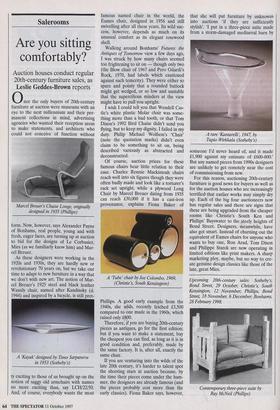Salerooms
Are you sitting comfortably?
Auction houses conduct regular 20th-century furniture sales, as Leslie Geddes-Brown reports
Once the only buyers of 20th-century furniture at auction were museums with an eye to the next millennium and their per- manent collections in mind, advertising agencies who wanted their reception areas to make statements, and architects who could not conceive of function without Marcel Breuer's Chaise Longe, originally designed in 1935 (Phillips) form. Now, however, says Alexander Payne of Bonhams, real people, young and with fresh, eager faces, are turning up at auction to bid for the designs of Le Corbusier, Mies (as we familiarly know him) and Mar- cel Breuer.
As these designers were working in the 1920s and 1930s, they are hardly new or revolutionary 70 years on, but we take our time to adapt to new furniture in a way that we don't with new art. The notion of Mar- cel Breuer's 1925 steel and black leather Wassily chair, named after Kandinsky (d. 1944) and inspired by a bicycle, is still pret- A 'Kayak' designed by Timo Sarpaneva in 1953 (Sotheby's) ty exciting to those of us brought up on the notion of saggy old armchairs with names no more exciting than, say LCH/22/50. And, of course, everybody wants the most famous named chair in the world, the Eames chair, designed in 1956 and still swivelling after all these years. Its wild suc- cess, however, depends as much on its unusual comfort as its elegant rosewood shell.
Walking around Bonhams' Futures: the Antiques of Tomorrow view a few days ago, I was struck by how many chairs seemed too frightening to sit on — though only two (the Blow chair of 1967 and Pero Gilardi's Rock, 1970, had labels which cautioned against such temerity). They were either so spare and pointy that a rounded buttock might get wedged, or so low and unstable that the supercilious minders at the view might have to pull you upright.
I wish I could tell you that Wendell Cas- tle's white plastic Molar chair was some- thing more than a bad tooth, or that Tom Dixon's 1992 Bird Chaise didn't send you flying, but to keep my dignity, I failed in my duty. Philip Michael Wolfson's 'Chair' (note the quotation marks) didn't even claim to be something to sit on, being described variously as abstracted and deconstructed.
Of course, auction prices for these famous chairs bear little relation to their ease. Charles Rennie Mackintosh chairs reach well into six figures though they were often badly made and look like a torturer's rack set upright, while a plywood Long Chair by Marcel Breuer dating from 1935 can reach £30,000 if it has a cast-iron provenance, explains Fiona Baker of A 'Tube' chair by Joe Colombo, 1969, (Christie's, South Kensington) Phillips. A good early example from the 1940s, she adds, recently fetched £3,500 compared to one made in the 1960s, which raised only £800.
Therefore, if you are buying 20th-century pieces as antiques, go for the first edition; but if you want tc) make a statement, buy the cheapest you can find, as long as it is in good condition and, preferably, made by the same factory. It is, after all, exactly the same chair.
If you are venturing into the wilds of the late 20th century, it's harder to talent spot the shooting stars at auction because, by the time their pieces come under the ham- mer, the designers are already famous (and the pieces probably cost more than the early classics). Fiona Baker says, however, that she will put furniture by unknowns into auctions 'if they are sufficiently stylish'. 'I put in a three-piece suite made from a storm-damaged mediaeval barn by A rare Wantarelr, 1947, by Tapio Wirklcala (Sotheby's) someone I'd never heard of, and it made £1,900 against my estimate of £600-800.' But any named pieces from 1990s designers are unlikely to get remotely near the cost of commissioning from new.
For this reason, auctioning 20th-century furniture is good news for buyers as well as for the auction houses who are increasingly terrified, that earlier works may simply dry up. Each of the big four auctioneers now has regular sales and there are signs that these are being upgraded from the cheaper rooms like Christie's South Ken and Phillips' Bayswater to the steely heights of Bond Street. Designers, Meanwhile, have also got smart. Instead of churning out the equivalent of Eames chairs for anyone who wants to buy one, Ron Arad, Tom Dixon and Philippe Starck are now operating in limited editions like print makers. A sharp marketing ploy, maybe, but no way to cre- ate genuine design classics like those of the late, great Mies.
Upcoming 20th-century sales: Sotheby's, Bond Street, 29 October; Christie's, South Kensington, 12 November; Phillips, Bond Street, 18 November, 6 December; Bonhams, 28 February 1998.
Contemporary three-piece suite by Ray McNeil (Phillips)


















































































 Previous page
Previous page